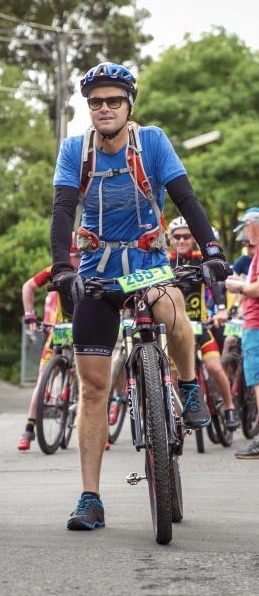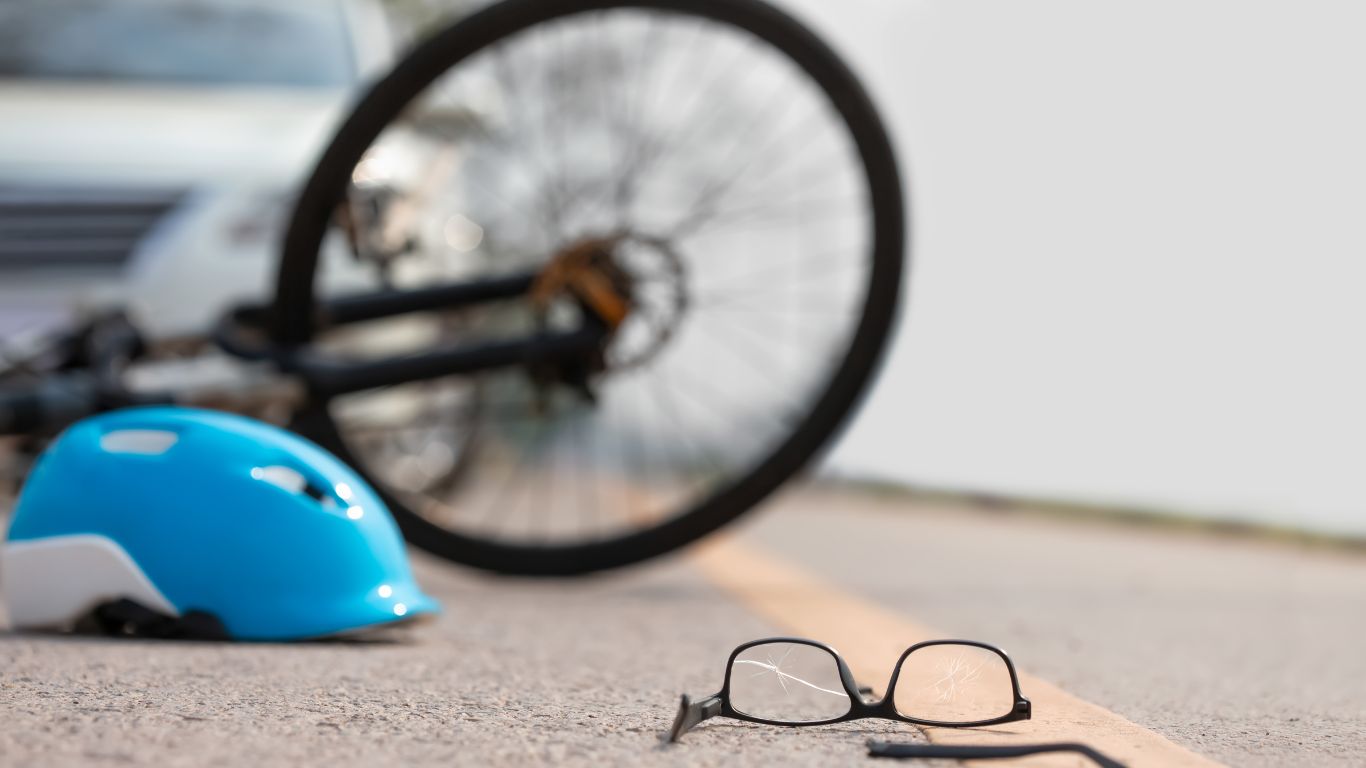A recent guest post by Dr Rob Burrell struck a real chord. It was about the irony of how dangerous it is to bike to one of Auckland’s biggest hospitals – despite cycling being one of the healthiest commutes there is.
Now, Rob’s anaesthetist colleague Dr Craig Birch follows up with his own story of how difficult it is to bike safely to Middlemore. Content warning: two grisly crashes, resulting in what would officially qualify as merely ‘minor’ injuries.
I have cycled to Middlemore Hospital, where I work as an anaesthetist, for many years – since 2001. Unfortunately, safety issues have meant that I’ve had to resort to getting in my car and joining the queues on the motorway more often.
My commute is a flat 16km ride, and at 40-45 minutes on the bike I would sometimes get to work or home in less time than it would take me in the car. I’d arrive at work feeling energised by the exercise, and it’s an easy way to fit exercise into my daily routine. Also, as traffic has worsened over the years, it has become more appealing to be able to go by bike and stay off the motorways.
Last year, however, I was twice hit by cars. In both cases, I was very lucky to escape with just flesh wounds and no broken bones or worse – but it has left me feeling extremely vulnerable, and fearful of cycling in the South Auckland traffic.
My route from Glendowie first takes me through Glen Innes to Point England. This part is relatively safe, even though there are no cycle paths. The roads are reasonably wide, and are commonly used by people biking for exercise. Riverside Road in Point England is the highlight of my ride, with great views of the Tamaki Estuary.
I make my way over the Panmure footbridge, and then onto Waipuna Road where I am faced with two equally dangerous options: I either turn left onto Carbine Road or continue straight and trust my luck on the Mount Wellington Highway.
Carbine Road is a busy four-lane road though the Mt Wellington industrial area, and it was here that I had my first collision with a car last year.
I was riding south, and crossed the Southeastern Motorway (SH10), after which a car crossed in front of me at the intersection of Carbine Road and Bowden Rd. Fortunately, I saw him coming and slowed down considerably – so, while I landed on his bonnet and took the skin off my shins and knees and right elbow (plus a big ‘tar burn’ on my right backside), no more major damage was done.
The motorist was apologetic and said that he simply failed to see me. I should add that I cycle with front and rear lights flashing, and wear a high-vis bright yellow fluorescent jacket and backpack.
The alternative to Carbine Road is to ride on the footpath on the Mt Wellington Highway – a footpath that disappears before the Sylvia Park shopping area. One then has to cross several lanes of the very busy Mt Wellington Highway to access a cycle path that leads to Great South Road, another treacherous option that leads south.
On balance, Carbine Road is probably the safer option.
From Carbine Road, I turn right at Panama Road and head towards Otahuhu. This is a relatively quiet suburban area, although the roads are narrow, and I have had a few close shaves with buses and cars.
I then have to make my way across the southern part of the Mt Wellington Highway, which is where – just a month after my first crash – I was again struck by a car turning across the road in front of me. This time, I was traveling faster and so was unable to avoid smashing into the car’s windscreen. Once again, I was very fortunate not to be really badly injured. Crashing into the car windscreen amazingly softened the blow, shattering the glass but leaving me relatively well off! Had I missed the windscreen, or hit at a different angle, I’m sure I’d have had broken bones, or worse.
The driver apologised profusely and was shocked at what he had done. He had not seen me, and was really distressed. We spoke for a while on the side of the road, and he was eager to help me get where I needed to go, but could no longer drive his car.
In neither case did I contact the police. Why? Mainly because I felt the drivers were just as upset as I was, and were so apologetic, and I didn’t feel there was much to be gained.* My bike was buckled by the second crash, and I took it to a bike shop. They wrote it off, deeming it unsafe to fix as the frame was damaged, and I received an insurance payout.
In both cases, my recovery time was a few weeks for physical aches and pains to heal up, but it’s taken a lot longer that that for me to get my mojo back about cycling in traffic. I still feel nervous!
As for the rest of my commute: it’s reasonably easy to get through the old Otahuhu village, but then one has to navigate the increasingly busy Massey Road, which has no shoulder, so one shares a narrow lane with passing cars. It was always a relief to turn left onto Golf Road, for the final stretch to the hospital. (Note: this is just a description of my journey to work; the ride back home is always worse, as there are more cars on the road in the evening.)
Recently, this lack of safety on my route – and the impact of those two crashes – has kept me off my bike. There’s no question in my mind that safer infrastructure would have prevented both collisions, which occurred when drivers turned carelessly across my path. I would love to commute by bike again, if there were a safe option to do so. However, I have tried all the approaches to Middlemore from the northeast, and there is simply no safe cycle route right now.
–Craig Birch
*A note from Bike Auckland on what to do if you have a bike crash
Nine in ten reported bike crashes in New Zealand happen on city streets. And, at least in theory, roading agencies rely on this crash data when making decisions about where to invest in safety upgrades and bike networks. So every single data point matters.
And yet: studies suggest that up to 70% of bike crashes are never officially reported – never mind the daily near misses we all experience. You see the problem.
So, while Craig’s stoic response of dusting himself off and limping away is not unusual, we strongly recommend reporting any crash with a motor vehicle, whether it results in serious injury or not.
Why you should report even a minor crash
It’s actually a legal requirement to report any injury crashes involving a motor vehicle to local police as soon as practicable, and no later than 24 hours from the time of the crash.
We understand that making a report may be the last thing you have energy or time for after a crash.
If your crash is serious enough to be attended by emergency staff, it’s highly likely police will file a report – but always worth you or a family member or supporter checking that they actually have, and asking to be kept up to date with any developments.
If police do not attend the crash, it’s up to you to go to a station and file a report within 24 hours. It’s then usually up to you to follow up and find out what’s happened to your case. And, while some officers are highly responsive and supportive, we also hear of uneven responses when it comes to crashes involving people on bikes. Be patient, polite, and persistent: they’re there to help you.
Witnesses, helpers, and bystanders are also extremely helpful – so don’t be shy to ask for their help in the moment and afterwards. Even if you don’t feel badly hurt, concussion can be delayed, and shock and adrenaline can make it hard to focus. Look to people on the spot to help provide independent correlation, photographs, number plates, phone numbers, and other details, and to offer a steady hand for making notes or phone calls on your behalf if you’re feeling shaky.
What if you don’t want the driver to be charged
This is a surprisingly common response among people on bikes after a minor crash, especially when drivers are apologetic and shaken up and SMIDSY (‘Sorry Mate, I Didn’t See You’). Reporting a crash doesn’t automatically mean charges will be laid – that’s up to the investigating officers.
Remember: the biggest benefit of reporting every crash is that it’s entered into the nationwide Crash Analysis System (CAS), which helps build a picture of the true state of our streets for people on bikes, and influences funding and safety decisions. Even if you feel comfortable not pursuing the crash outcome any further, taking a moment to put it on the map where it may protect you and other riders in future? Priceless.
Of course, reporting a crash to the police also has benefits when it comes to insurance claims. Having a crash report (with or without a charge against an offending motorist) makes it easier for the insurance company to pay you out and, if needed, pursue the other party for reparations.
How to report near misses and risky driving in general
If you experience a near miss or witness dangerous driving (like this absolute shocker), call *555 (or use the online form) to phone it in to Community Road Watch. From experience, we know their phone operators are very patient, and are used to people blurting out the number plate first, before getting to the other details.
After you submit the report, a letter will be sent to the driver noting their poor driving has been observed. This may sound like a wet-bus-ticket-in-a-bottle, but we’ve heard of at least one case in which a *555 report suddenly and immediately became very interesting to the police after a vehicle matching the description shortly afterwards blew a red light and hit another car. So if you see something, say something. The life you save may be your own.
Volunteer callout: Are you a legal eagle, keen to help people on bikes?
In the context of all of the above, we’re keen to beef up our capacity to support people on bikes when the worst happens – which is why Bike Auckland is looking for a volunteer legal advisor. If you have legal expertise (especially in the area of traffic law), a passion for making Auckland a better place for people on bikes, and a few hours a month to contribute, we would love to hear from you!





